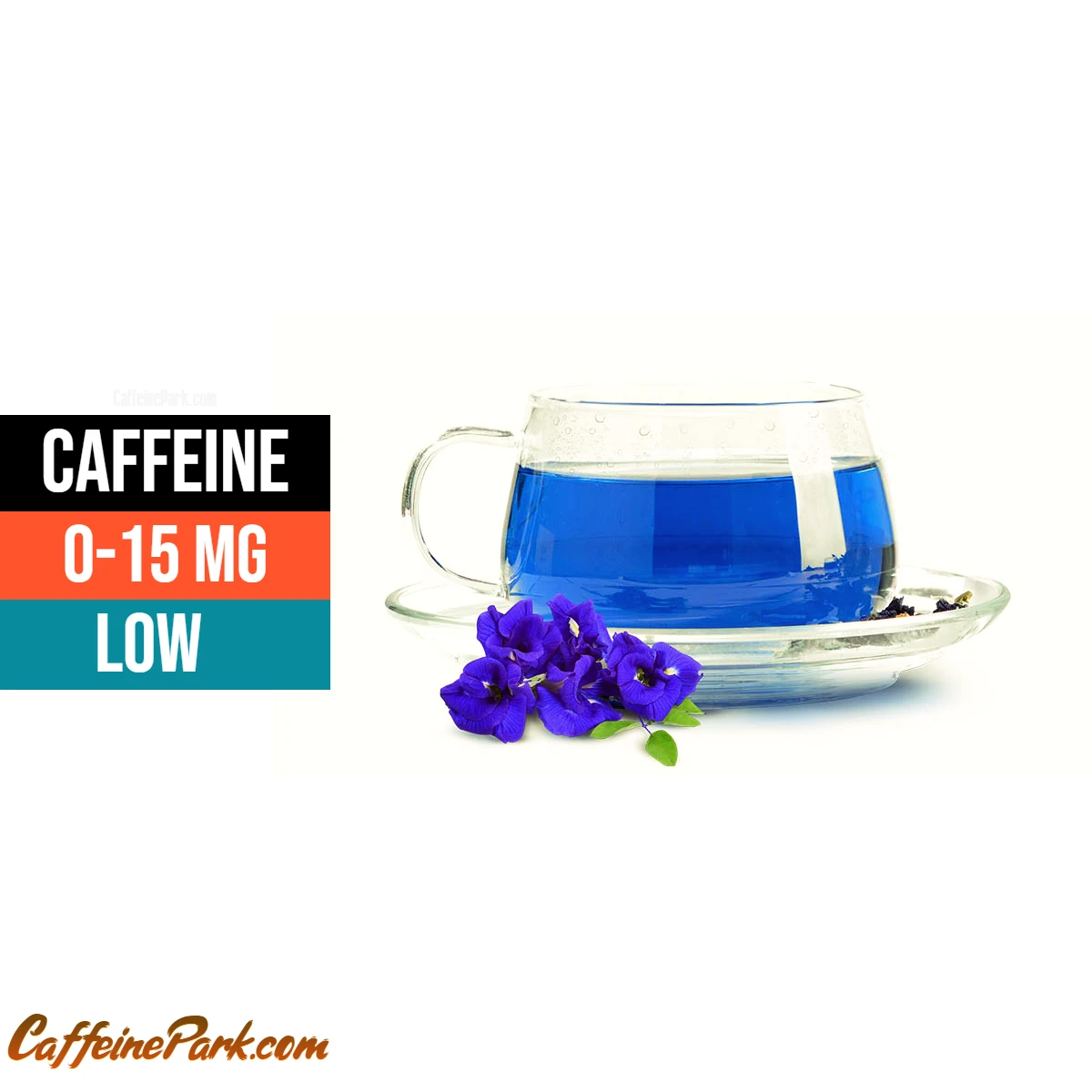Blue tea Caffeine Content

Blue tea, also known as butterfly pea flower tea, has become increasingly popular in recent years due to its unique and vibrant blue color. But many people are wondering, does blue tea contain caffeine? In this article, we will explore the caffeine content of blue tea and answer some common questions about this trendy beverage.
Blue tea is made from the butterfly pea flower, which is native to Southeast Asia. The flowers are typically steeped in hot water to create a blue-hued tea that has a slightly earthy and floral flavor. Blue tea is also sometimes mixed with other ingredients, such as lemon or honey, to enhance its taste.
Does Blue Tea Contain Caffeine?
One of the most common questions about blue tea is whether or not it contains caffeine. The answer is yes, blue tea does contain caffeine, although the amount can vary depending on how it is prepared.
On average, an 8-ounce cup of blue tea contains between 0 and 15 milligrams of caffeine. This is a relatively small amount compared to other types of tea, such as black tea, which contains around 47 milligrams of caffeine per cup.
However, it’s worth noting that the caffeine content of blue tea can vary depending on how it is brewed. If the tea is steeped for longer periods of time or with hotter water, it can result in a higher caffeine content. Additionally, if the tea is mixed with other ingredients that contain caffeine, such as green tea or coffee, the overall caffeine content of the beverage will be higher.
Benefits of blue tea
Blue tea, also known as butterfly pea flower tea, is a type of herbal tea made from the dried petals of the butterfly pea plant. Here are some potential benefits of drinking blue tea:
- Rich in antioxidants: Blue tea contains antioxidants called anthocyanins, which have been shown to protect the body against damage from free radicals. This can help reduce the risk of chronic diseases such as cancer, heart disease, and diabetes.
- May improve cognitive function: Some studies have found that blue tea may improve cognitive function, including memory and concentration. This may be due to the tea’s ability to increase blood flow to the brain and reduce inflammation.
- May have anti-inflammatory effects: Blue tea has been found to have anti-inflammatory properties, which may help reduce inflammation in the body and prevent chronic diseases.
- May have a calming effect: Blue tea contains a compound called apigenin, which has been found to have a calming effect on the body. This can help reduce stress and anxiety.
- May promote healthy skin: The antioxidants in blue tea may help protect the skin against damage from free radicals, which can cause premature aging. Some studies have also found that blue tea may help improve skin hydration and reduce the appearance of wrinkles.
- May help regulate blood sugar levels: Blue tea has been found to help regulate blood sugar levels, which may be beneficial for people with diabetes. This may be due to the tea’s ability to inhibit the absorption of glucose in the intestines.
- May promote weight loss: Blue tea has been found to have a slight diuretic effect, which may help reduce water retention and promote weight loss. Additionally, the tea’s ability to regulate blood sugar levels may also be beneficial for weight management.
Overall, blue tea is a healthy and delicious beverage that may offer a range of health benefits. However, more research is needed to fully understand the extent of these benefits and how they may vary from person to person.
Side Effects of Blue tea
While blue tea is generally considered safe to consume in moderate amounts, there are some potential side effects to be aware of:
- Low blood pressure: Blue tea has been found to have a slight blood pressure-lowering effect. While this can be beneficial for people with high blood pressure, it may be a concern for those with low blood pressure. If you have low blood pressure, you should consult with your doctor before consuming blue tea.
- Allergic reactions: Some people may be allergic to butterfly pea flowers, which are used to make blue tea. If you experience symptoms such as itching, hives, or difficulty breathing after consuming blue tea, you should stop drinking it and seek medical attention.
- Interference with medications: Blue tea may interfere with the absorption of certain medications, including those for diabetes and high blood pressure. If you are taking medication, you should consult with your doctor before consuming blue tea.
- Staining of teeth and clothes: Blue tea has a vibrant blue color that can stain teeth and clothes. It is recommended to drink blue tea with a straw and to rinse your mouth with water after drinking it to prevent staining.
- Digestive issues: Some people may experience digestive issues such as bloating or diarrhea after consuming blue tea. This may be due to the tannins in the tea, which can be irritating to some people’s digestive systems.
Overall, blue tea is considered safe for most people to consume in moderation. However, if you have any concerns or experience any adverse effects after consuming blue tea, you should consult with your doctor.
How to Brew Blue Tea
Brewing blue tea is a simple and straightforward process. Here’s how to do it:
- Start by boiling water. You can use a kettle or a pot to boil water on the stove. The ideal temperature for brewing blue tea is between 80-85°C (176-185°F).
- Once the water has reached the desired temperature, add the blue tea leaves or flowers to the water. Use approximately 1 tablespoon of loose blue tea or 2-3 tea bags per 8-ounce cup of water.
- Let the tea steep for 3-5 minutes. The longer you steep the tea, the stronger the flavor and color will be.
- Once the tea has finished steeping, remove the tea leaves or bags from the water. You can discard the tea leaves or reuse them for a second steeping.
- If desired, you can add sweetener or lemon juice to the tea. Blue tea has a mild flavor, so it pairs well with a variety of sweeteners and flavors.
- Pour the tea into a cup and enjoy!
Note: Blue tea can also be brewed using cold water, which results in a lighter color and flavor. To make cold-brewed blue tea, simply add the tea leaves or flowers to cold water and let it steep in the refrigerator for 6-8 hours or overnight.
Different Ways to Enjoy Blue Tea
Aside from traditional hot and iced blue tea, there are plenty of other ways to enjoy this trendy beverage. Here are a few ideas:
- Blue Tea Latte: Add a shot of espresso and steamed milk to a cup of blue tea for a unique twist on a classic latte.
- Blue Tea Smoothie: Blend blue tea with frozen berries, a banana, and some almond milk for a delicious and healthy smoothie that’s packed with antioxidants.
- Blue Tea Cocktail: Mix blue tea with vodka, lemon juice, and simple syrup for a refreshing and boozy cocktail.
- Blue Tea Lemonade: Combine blue tea with freshly squeezed lemon juice and sweeten with honey or agave for a refreshing and tart lemonade with a beautiful blue color.
- Blue Tea Ice Cream: Infuse blue tea into a classic vanilla ice cream base for a unique and delicious dessert that’s sure to impress.
Final Thoughts
Blue tea is a unique and tasty beverage that offers a range of health benefits. While it does contain some caffeine, the amount is relatively small compared to other types of tea. So if you’re looking for a caffeine-free option, you might want to try herbal teas such as chamomile or peppermint.
If you’re interested in trying blue tea, be sure to brew it properly to get the best flavor and color. And don’t be afraid to get creative with how you enjoy it! From lattes to cocktails to ice cream, there are plenty of ways to incorporate blue tea into your daily routine.
FAQs
On average, an 8-ounce cup of blue tea contains between 0 and 15 milligrams of caffeine, although the amount can vary depending on how it is prepared.
Yes, blue tea is a good alternative to coffee for people who are sensitive to caffeine. While it does contain some caffeine, the amount is relatively small compared to coffee and other types of tea.
Yes, the caffeine content of blue tea can vary depending on how it is brewed. If the tea is steeped for longer periods of time or with hotter water, it can result in a higher caffeine content.
Yes, blue tea can be mixed with other types of tea or coffee, which can result in a higher overall caffeine content.
Yes, blue tea contains antioxidants and flavonoids, which have been linked to a reduced risk of chronic diseases such as cancer, diabetes, and heart disease. It has also been found to have a calming effect on the body, which can help reduce stress and anxiety.
Read More:





